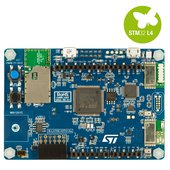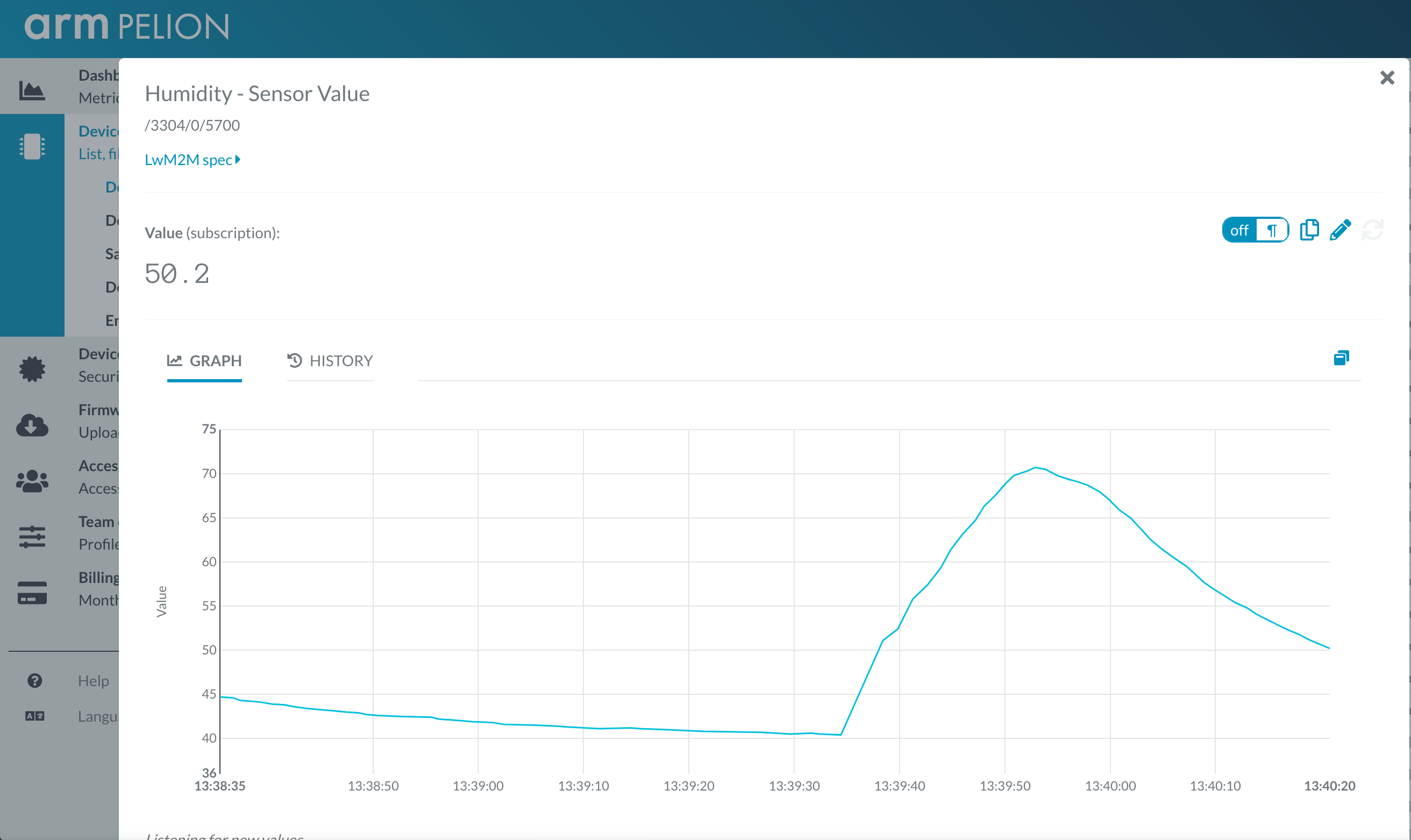Mbed OS and Pelion Device Management example over WIFI for DISCO_L475VG_IOT01 board
Dependencies: X_NUCLEO_COMMON ST_INTERFACES
DEPRECATED
This example application is not maintained and not recommended. It uses an old version of Mbed OS, Pelion DM and Arm toolchain. It doesn't work with Mbed Studio.
Please use: https://os.mbed.com/teams/mbed-os-examples/code/mbed-os-example-pelion/
This example is known to work on the following platforms:
- DISCO_L475E_IOT01A over WiFI and using onboard QSPI flash.

Follow the Quick-Start instructions: https://cloud.mbed.com/quick-start
Example functionality
This example showcases the following device functionality:
- Read onboard temperature and humidity sensors, and report them as Pelion LWM2M resources (see image below).
- On user button click, increment Pelion LWM2M button resource.
- Allow the user to change the state of the board LED from Pelion LWM2M led_state resource and PUT request.
- Uses all onboard sensors and reports them as Pelion LWM2M resources.

Use this example with Mbed CLI
1. Import the application into your desktop:
mbed import https://os.mbed.com/teams/ST/code/pelion-example-disco-iot01 cd pelion-example-disco-iot01
2. Install the CLOUD_SDK_API_KEY
mbed config -G CLOUD_SDK_API_KEY <PELION_DM_API_KEY>
For instructions on how to generate your API key, please see the documentation.
3. Initialize firmware credentials (done once per repository). You can use the following command:
mbed dm init -d "<your company name in Pelion DM>" --model-name "<product model identifier>" -q --force
If above command do not work for your Mbed CLI, please consider upgrading Mbed CLI to version 1.8.x or above.
4. Compile and program:
mbed compile -t <toolchain> -m DISCO_L475VG_IOT01A
(supported toolchains : GCC_ARM / ARM / IAR)
5. You can connect on a virtual terminal/COM port to the platform using:
mbed sterm -b 115200
This should give you an output similar to:
[BOOT] Mbed Bootloader [BOOT] ARM: 00000000000000000000 [BOOT] OEM: 00000000000000000000 [BOOT] Layout: 0 80096F4 [BOOT] Active firmware integrity check: [BOOT] SHA256: 0660E360D432225D5251461998FD8617B017098C5F1F90D5FB607BF8C27ED530 [BOOT] Version: 1553615309 [BOOT] Slot 0 is empty [BOOT] Active firmware up-to-date [BOOT] Application's start address: 0x8010400 [BOOT] Application's jump address: 0x8011041 [BOOT] Application's stack address: 0x20018000 [BOOT] Forwarding to application... Starting Simple Pelion Device Management Client example You can hold the user button during boot to format the storage and change the device identity. Sensors configuration: Invalid new address! HTS221 humidity & temperature = 0xBC LPS22HB pressure & temperature = 0xB1 LIS3MDL magnetometer = 0x3D LSM6DSL accelerometer & gyroscope = 0x6A Connecting to the network using Wifi... Connected to the network successfully. IP address: 192.168.1.3 Initializing Pelion Device Management Client... Initialized Pelion Client. Registering... Registered to Pelion Device Management. Endpoint Name: 0169********************001002d5 ADC temp: 23.0037 C, vref: 0.3661 V HTS221 temp: 28.700 C, humidity: 31.90 % LPS22HB temp: 29.600 C, pressure: 1032.01 mbar LIS3MDL mag: 0.217 x, -0.284 y, -0.053 z [gauss] LSM6DSL acc: 0.005 x, -0.014 y, 1.029 z [g] LSM6DSL gyro: 0.910 x, -0.910 y, 1.120 z [dps] VL53L0X dist: 1855 mm
main.cpp
- Committer:
- MarceloSalazar
- Date:
- 2018-10-14
- Revision:
- 9:265744785d33
- Parent:
- 6:e0e1e1b93099
- Child:
- 10:b27c962b3c3f
File content as of revision 9:265744785d33:
// ----------------------------------------------------------------------------
// Copyright 2016-2018 ARM Ltd.
//
// SPDX-License-Identifier: Apache-2.0
//
// Licensed under the Apache License, Version 2.0 (the "License");
// you may not use this file except in compliance with the License.
// You may obtain a copy of the License at
//
// http://www.apache.org/licenses/LICENSE-2.0
//
// Unless required by applicable law or agreed to in writing, software
// distributed under the License is distributed on an "AS IS" BASIS,
// WITHOUT WARRANTIES OR CONDITIONS OF ANY KIND, either express or implied.
// See the License for the specific language governing permissions and
// limitations under the License.
// ----------------------------------------------------------------------------
#ifndef MBED_TEST_MODE
#include "mbed.h"
#include "simple-mbed-cloud-client.h"
#include "FATFileSystem.h"
// An event queue is a very useful structure to debounce information between contexts (e.g. ISR and normal threads)
// This is great because things such as network operations are illegal in ISR, so updating a resource in a button's fall() function is not allowed
EventQueue eventQueue;
// Default network interface object
NetworkInterface *net;
// Default block device
BlockDevice* bd = BlockDevice::get_default_instance();
FATFileSystem fs("sd", bd);
// Declaring pointers for access to Pelion Client resources outside of main()
MbedCloudClientResource *button_res;
MbedCloudClientResource *pattern_res;
// This function gets triggered by the timer. It's easy to replace it by an InterruptIn and fall() mode on a real button
void fake_button_press() {
int v = button_res->get_value_int() + 1;
button_res->set_value(v);
printf("Simulated button clicked %d times\n", v);
}
/**
* PUT handler
* @param resource The resource that triggered the callback
* @param newValue Updated value for the resource
*/
void pattern_updated(MbedCloudClientResource *resource, m2m::String newValue) {
printf("PUT received, new value: %s\n", newValue.c_str());
}
/**
* POST handler
* @param resource The resource that triggered the callback
* @param buffer If a body was passed to the POST function, this contains the data.
* Note that the buffer is deallocated after leaving this function, so copy it if you need it longer.
* @param size Size of the body
*/
void blink_callback(MbedCloudClientResource *resource, const uint8_t *buffer, uint16_t size) {
printf("POST received. Going to blink LED pattern: %s\n", pattern_res->get_value().c_str());
static DigitalOut augmentedLed(LED1); // LED that is used for blinking the pattern
// Parse the pattern string, and toggle the LED in that pattern
string s = std::string(pattern_res->get_value().c_str());
size_t i = 0;
size_t pos = s.find(':');
while (pos != string::npos) {
wait_ms(atoi(s.substr(i, pos - i).c_str()));
augmentedLed = !augmentedLed;
i = ++pos;
pos = s.find(':', pos);
if (pos == string::npos) {
wait_ms(atoi(s.substr(i, s.length()).c_str()));
augmentedLed = !augmentedLed;
}
}
}
/**
* Notification callback handler
* @param resource The resource that triggered the callback
* @param status The delivery status of the notification
*/
void button_callback(MbedCloudClientResource *resource, const NoticationDeliveryStatus status) {
printf("Button notification, status %s (%d)\n", MbedCloudClientResource::delivery_status_to_string(status), status);
}
/**
* Registration callback handler
* @param endpoint Information about the registered endpoint such as the name (so you can find it back in portal)
*/
void registered(const ConnectorClientEndpointInfo *endpoint) {
printf("Connected to Pelion Device Management. Endpoint Name: %s\n", endpoint->internal_endpoint_name.c_str());
}
int main(void) {
printf("Starting Simple Pelion Device Management Client example\n");
printf("Connecting to the network using Wifi...\n");
// Connect to the internet (DHCP is expected to be on)
net = NetworkInterface::get_default_instance();
nsapi_error_t status = net->connect();
if (status != NSAPI_ERROR_OK) {
printf("Connecting to the network failed %d!\n", status);
return -1;
}
printf("Connected to the network successfully. IP address: %s\n", net->get_ip_address());
// SimpleMbedCloudClient handles registering over LwM2M to Pelion DM
SimpleMbedCloudClient client(net, bd, &fs);
int client_status = client.init();
if (client_status != 0) {
printf("Pelion Client initialization failed (%d)\n", client_status);
return -1;
}
// Creating resources, which can be written or read from the cloud
button_res = client.create_resource("3200/0/5501", "button_count");
button_res->set_value(0);
button_res->methods(M2MMethod::GET);
button_res->observable(true);
button_res->attach_notification_callback(button_callback);
pattern_res = client.create_resource("3201/0/5853", "blink_pattern");
pattern_res->set_value("500:500:500:500:500:500:500:500");
pattern_res->methods(M2MMethod::GET | M2MMethod::PUT);
pattern_res->attach_put_callback(pattern_updated);
MbedCloudClientResource *blink_res = client.create_resource("3201/0/5850", "blink_action");
blink_res->methods(M2MMethod::POST);
blink_res->attach_post_callback(blink_callback);
printf("Initialized Pelion Client. Registering...\n");
// Callback that fires when registering is complete
client.on_registered(®istered);
// Register with Pelion DM
client.register_and_connect();
// Placeholder for callback to update local resource when GET comes.
// The timer fires on an interrupt context, but debounces it to the eventqueue, so it's safe to do network operations
Ticker timer;
timer.attach(eventQueue.event(&fake_button_press), 5.0);
// You can easily run the eventQueue in a separate thread if required
eventQueue.dispatch_forever();
}
#endif

